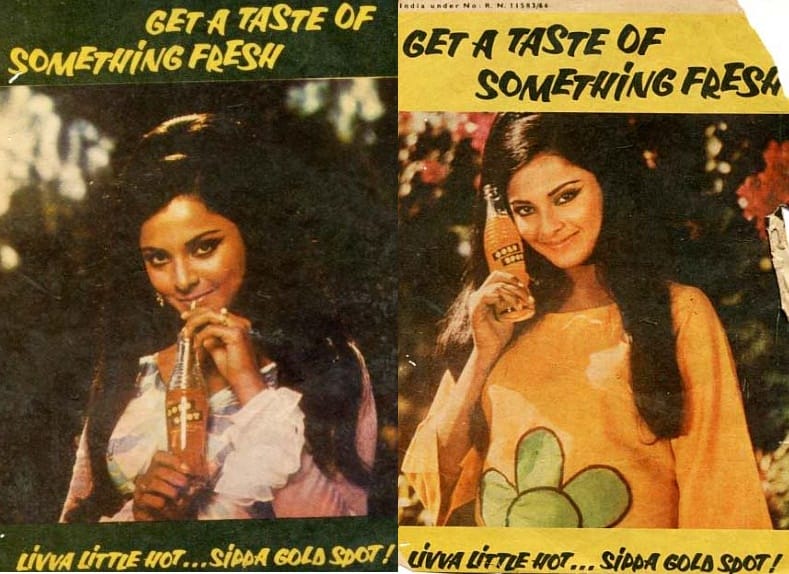Long before Fanta or Mirinda, the reigning queen of the orange soda market was Parle’s Gold Spot.
India’s romance with cola did not start with “Yehi hai right choice, baby, aha”. It began with a punchline that didn’t really say anything, but managed to convey light-hearted fun – “The zing thing”.
Long before Fanta or Mirinda domination, the reigning queen of the orange soda market was Parle’s Gold Spot. For obvious reasons, it was a favourite among children.
“We were fond of Gold Spot. Although Coca-Cola was very famous those days, it was a sharp and fizzy drink, which left a bitter taste in our mouth. Gold Spot was sweet and I can recall myself standing in front of the mirror with our mouths wide open and tongue sticking out, both stained with orange colour,” said Anjana Trivedi, 45.
But Gold Spot did not just conquer the children’s segment, it also wanted to capture the youth market with stylish advertisements that showed young fashionable bell-bottomed men and young women dancing. Commercials also showed young couples skating and jiving in a cafeteria. The simple message in the jingle was: He is crazy about me, and she is crazy about me, and both are as crazy as they are for Gold Spot.
“Whenever I pass by the Parle factory in Mumbai, I go back to my school days. My school once organised a Gold Spot factory tour as part of the annual picnic. And when we sat back in the bus, our lips were stained with orange colour,” recalled Sanket Chaturvedi, a 53-year-old banker.
Also read: Campa Cola was India’s answer to Coca-Cola and was the perfect fit
Behind the scene
Gold Spot’s owner Ramesh Chauhan, the chairman of Parle Products, bitterly opposed the entry of American cola companies in the late 1980s. He also owned Thums Up and Limca. Till then, Gold Spot ruled the market with its innovative ads and a good understanding of its demographic.
“Some years after the launch of Gold Spot, the company faced some problem with its flavour. They decided to introduce a minor change in the flavour and called us to design the campaigns,” said Prahlad Kakkar, the celebrated adman who created both “The zing thing” and “Yehi hai right choice baby, aha” punchlines.
Kakkar shot an advertisement, which would also talk about the company’s product Limca.
“The ad was shot in a college canteen and we wanted a funny looking fellow to talk about ‘Limca’ and then say, ‘Oops, I forgot, it’s a Gold Spot campaign’,” Kakkar recalled.
“The idea was vague and as presumed, it turned out to be a tough task for the entire team as Ramesh [Chauhan] was not sure about it. He said, ‘How can we talk about Limca here, it’s silly.’ After a lot of back and forth, he was convinced. After all, we wanted something silly to get noticed.”
Also read: Murphy Radio and a bonny baby are what pre-TV Indian memories are made of
The history behind the brand
In the 1940s, Mumbai-based food company Parle was known for a popular brand of glucose biscuits, Parle Gluco or Parle-G as we know it. To cash in on its established brand equity, in 1949, Parle ventured into the cola market with ‘Gluco Cola’. Known for its sharp marketing campaigns, the company hired legendary cartoonist, R.K. Laxman, to design the advertisements. The tagline was “India’s first cola”.
But the brand faced several hiccups after its take off. Soft drink behemoth Coca-Cola entered India one year after the launch of Gluco Cola, and took offence over the similar-sounding brand name and even threatened to go to court. Parle renamed its brand to ‘Parle Cola’, but Coca-Cola was still unhappy. Parle decided to discontinue its cola brand in 1951.
In 1952, Parle came back and launched an orange-flavoured fizzy beverage Gold Spot, which was named after its popular peppermint product called Parle Gold Star. It established Gold Spot and lemon-based Limca (from limbu-ka) as successful brands, and never chose to introduce any cola drink. It positioned Limca as a ‘zero bacteria’ health drink for the upwardly mobile youth and Gold Spot became a drink for children. But soon Parle began to cede ground to the giant brand Coca-Cola.
Gold Spot tried to reinvent its image later to appeal to the young and hired a model in its advertisements, who was none other than Rekha.

The print ad featuring a very young Rekha in a bright orange top with a floral print and had a tagline, “Get a taste of something fresh: Livva little hot, sippa Gold Spot”.
“This campaign marked the shift of Rekha from the south Indian film industry to Bollywood. It was directed by Shyam Benegal, and in no time, the face of the model and tagline became the talk of the town,” said Kakkar.
Also read: Binaca was a brand that brought toothpaste and music together
In 1975, the Emergency was imposed, which impacted the market for soft drinks. People cut down on picnics and parties. Deep-pocketed Coca-Cola survived the slowdown, but Parle was hit badly after huge investments on bottling facilities.
“But we should take pride considering that Coca-Cola was a behemoth, they had humongous financial support and Gold Spot gave it a tough competition through its well strategised promotional campaign and unique flavour,” said Santosh Sood, former chief operating officer of advertising house, Rediffusion Y&R, who also handled Gold Spot’s promotions.
However, in 1977, Coca-Cola left India, protesting the government’s new regulations. When the full-blown ‘cola wars’ began again with the entry of Pepsi (1990) and re-entry of Coca-Cola (1993), Parle sold out to Coke reportedly for $40 million.
Soon, Coca-Cola discontinued Gold Spot and launched its own brands — Sprite and Fanta.







The ads for Limca were about the time Stardust was born, both part of our growing up years.